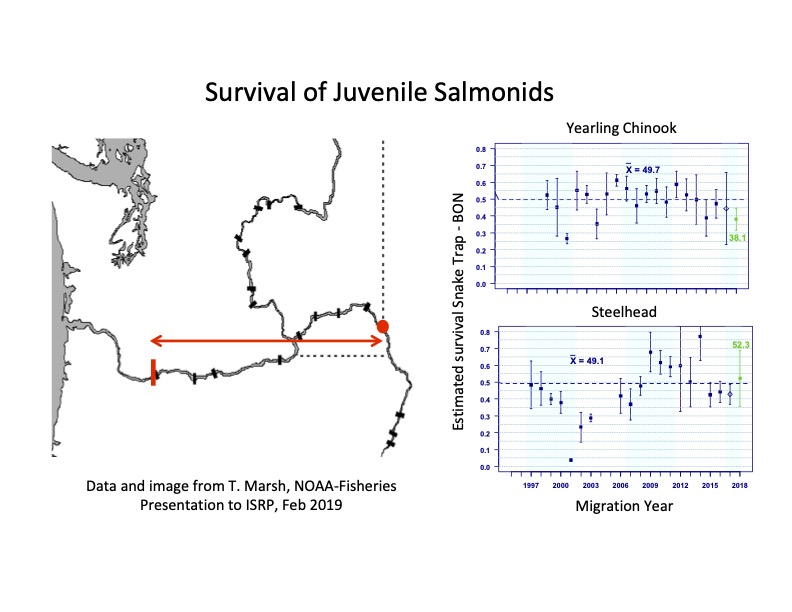forum
library
tutorial
contact

Collaboration on Dams Won't
Bring Back Salmon and Steelhead
by Scott Lake
Idaho Statesman, December 11, 2019
|
the film forum library tutorial contact |

|
Collaboration on Dams Won't
by Scott Lake
|
Keep the dams or keep the fish. We can't have both.
 In a recent story in the Idaho Statesman, Rocky Barker suggested a "collaborative" approach, similar to the 2009 Owyhee Initiative, to resolve longstanding conflicts surrounding the lower Snake River dams. Barker has long understood that leaving the dams in place is a death sentence for Idaho's steelhead and salmon runs. And it's encouraging to see politicians, including U.S. Rep. Mike Simpson, R-Idaho, finally discuss dam removal. But Barker's prescription for a collaborative approach based on the Owyhee Initiative is misguided.
In a recent story in the Idaho Statesman, Rocky Barker suggested a "collaborative" approach, similar to the 2009 Owyhee Initiative, to resolve longstanding conflicts surrounding the lower Snake River dams. Barker has long understood that leaving the dams in place is a death sentence for Idaho's steelhead and salmon runs. And it's encouraging to see politicians, including U.S. Rep. Mike Simpson, R-Idaho, finally discuss dam removal. But Barker's prescription for a collaborative approach based on the Owyhee Initiative is misguided.
This year marks the Owyhee Initiative's 10th anniversary, and it's worth examining what the Initiative has accomplished in that time. The Initiative's signature accomplishment -- the Omnibus Public Land Management Act of 2009 -- created six new wilderness areas in the Owyhee Canyonlands.
But in exchange, conservationists gave up a lot
For instance, the Owyhee Initiative's proposed bill would have allowed unlimited motorized travel by ranchers within designated wilderness. Thankfully, these proposals were modified by Congress. The final version of the 2009 Omnibus Act permitted motorized travel occasionally, and BLM has since clarified that motorized access is only allowed where no alternatives exist. Nevertheless, commercial livestock grazing continues in the Owyhee Canyonlands wildernesses much as it did before, meaning those areas today are far from the "untrammeled" landscape envisioned by the 1964 Wilderness Act.
The Owyhee Wilderness designations, moreover, did nothing to address the grazing-related environmental problems that have long plagued the region, and the Owyhee Initiative's emphasis on compromise and consensus has in some cases made matters worse. In the mid-1990s, the Clinton administration issued new grazing regulations designed to reverse decades of environmental degradation. Those regulations required BLM to meet specific ecological criteria for soils, streams, springs and wildlife habitat on federal grazing leases. BLM found that the vast majority of federal lands in the Owyhee region were failing these criteria due to overgrazing, prompting the 9th Circuit Court of Appeals to observe that "cattle overgrazing ... threatens the life of the Owyhee."
BLM tried to solve the problem by reducing cattle numbers and imposing seasonal restrictions on grazing, but ranchers resisted, and Initiative's newfound spirit of cooperation ultimately did little to address the problem. The fallout from the Clinton regulations lingers to this day, as the very same ranchers who took part in the Owyhee Initiative continue to resist grazing reform. Progress -- in the form of stocking reductions, grazing rest and new monitoring protocols -- has been stalled, and nearly 20 years later, most grazing allotments in the Owyhee area are still failing to meet BLM's rangeland health standards.
But perhaps the most troubling aspect of the Owyhee Initiative's legacy has been the way it turned environmental advocates into cheerleaders for extractive industry. The Initiative was consensus-based, and as with many other collaborative groups, participation came with an understanding that members would publicly support the collaborative's position. Consequently, environmental groups involved with the Initiative publicly opposed BLM decisions that would have reduced grazing to protect sensitive wildlife species and pushed Congress to allow more motorized travel in the Owyhee wilderness areas. The Owyhee effort also led to later collaborations that rejected science-based federal proposals to protect the greater sage-grouse in favor of the State of Idaho's less protective (and largely unenforceable) sage-grouse plan.
Which brings us back to the Snake River dams. As with other environmental crises, restoring Idaho's native salmon and steelhead runs requires bold action. The choice is clear and has been for some time: Keep the dams or keep the fish. We can't have both. So while it is encouraging to see a conversation growing around the possibility of dam removal, a collaborative approach, as Barker suggests, would consign dam removal to death-by-committee. It's a recipe for platitudes and goodwill and consensus on tangential issues, while the last remaining wild salmon and steelhead disappear from Idaho's rivers.
learn more on topics covered in the film
see the video
read the script
learn the songs
discussion forum
